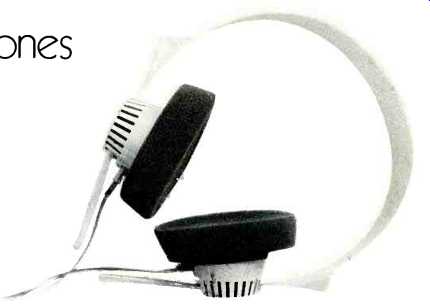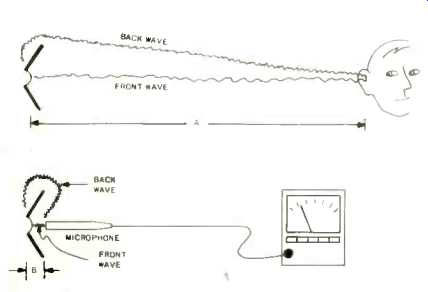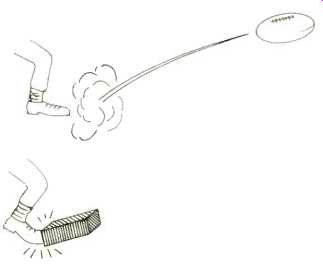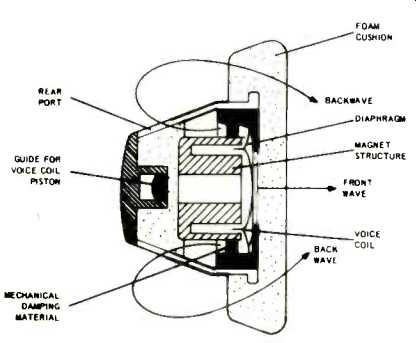
By Friedrich Warning [Sennheiser Electronic ]
DURING THE LAST DECADE, stereo headphones have become increasingly popular. Everyone who experiences headphone sound for the first time is amazed at the almost unbelievable difference in sound quality as compared to loudspeaker reproduction.
However, early headphone designs were not without their drawbacks. Conventional units, for example, required an airtight seal between phone and ear to achieve good low-frequency reproduction, for with the slightest leak, bass tones seemed to "drain" from program content. While the seal produced some possibly desirable effects, such as isolating the listener from his surroundings, some side effects made this a mixed blessing.
For one thing, the sense of isolation, except in special applications, often proved uncomfortable. To see why, one only need hold up a glass or cup to the ear. After a relatively short period of time, the constant pressure and lack of airflow generally proves annoying. Another problem is that the seal prevents ever-present body heat and moisture, as well as bass energy, from escaping, producing a warm and often humid environment that can quickly become uncomfortable, particularly on sticky days.
The headphone construction techniques required for this type of design also had some drawbacks; as some manufacturers produced increasingly heavy and more soundproof enclosures, some headphones became rather monstrous in size and weight. For the majority of listening situations, smaller size and weight are of definite importance, particularly for prolonged periods of time.
Getting Back to Basics
Because the "open-aire" approach to headphone design depends on a number of basic transducer phenomena, it might be well to review some of the principles originally discovered in loudspeaker research. Figure 1 shows the cone of an ordinary loudspeaker suspended in free air.

Fig. 1--Close to the speaker, phase […] is minimal, even at low

Fig. 2--Various speaker enclosures which eliminate, attenuate, or re-phase
back waves.

Fig. 3--An object with low mass moves easier and further when a force is
applied.
Early loudspeaker designers found that, at normal listening distances (A and beyond, Figure 1A), free-standing speakers are relatively inefficient at low frequencies. This is, of course, because sound waves generated by the rear of the speaker arrive at the ear with amplitudes nearly equal to those arriving from the front of the speaker.
Since, at low frequencies, the wavelengths are relatively long, sound energy from the rear of the speaker arrives almost perfectly out of phase with energy from the front of the speaker, resulting in a high degree of cancellation and poor or non-existant bass.
However, when the speaker's response is measured at distance B, which is close to the front side of the cone (actually, a distance less than the one's diameter), much better bass ... is measured. This is because, front wave travels a very short distance, the back wave's path is, relatively speaking, much longer. And when you consider that sound, like any form of energy, dissipates in intensity with the square of the distance between source and listener, the cancellation produced at B between front wave and back wave is negligible.
Of course, with a speaker system, it is impractical to move the listener to point B. To get around this problem, various types of enclosures were developed--infinite baffle, bass reflex, horn, etc. But all utilized the same basic principle, attenuate or eliminate the speaker's back wave (see Fig. 2). As the many excellent speakers on the market demonstrate, this has been successfully achieved.
But this was not done, however, without some compromise. Restricting the air-flow behind a speaker generally raises its resonance point which is not especially critical in a speaker system (since transducers may be readily made large and heavy enough to have low resonances even when enclosed), but quite another situation occurs when transducers are small, as in headphones.
When headphones are enclosed at the rear of the diaphragm, substantial increases must often be made in diaphragm size and/or mass, to re-attain low resonance frequency. Unfortunately, as moving mass increases, so does inertia. This can have detrimental effects on transient response, since higher masses require greater forces to move them (or longer time to get moving with equal applied force-see Fig. 3). Thus, with conventional headphone designs, it may be necessary to trade off transient response for better bass response (or vice versa).

Fig. 4--Cross-section of "open-aire" headphone.

Fig. 5--Response of Sennheiser HD 414 "open-aire" headphones.
The "Open-Aire" Design
Going back to Fig. 1B, we see that there are few response problems if the listener is relatively close to the speaker diaphragm. In fact, if distance "B" is less than the diameter of the cone (or diaphragm), we can ignore the nullifying effect of the back waves for all practical purposes. And if this is achievable, there is no longer any need to "bottle up" or attenuate the back wave, with associated resonance and transient response problems.
Now consider, for a moment, the ear's location with respect to the diaphragm of a headphone. You see the point-without resorting to a huge diaphragm, the ear is still less than half-a-diameter away from the diaphragm. It is precisely this "free-air" principle that is responsible for the excellent frequency and transient response of the "open-aire" design.
Figure 4 illustrates the cross-section of an "open-aire" headphone. A moving coil system is coupled to a diaphragm in the normal way. However, the housing at the rear of the driver element is perforated, to allow unrestricted passage of the sound generated by the rear of the moving diaphragm. There is no trapped air behind the diaphragm to raise resonance or inhibit transient response. So, with a diaphragm of proper weight, elasticity, and diameter, it is possible to obtain good low frequency response combined with excellent performance in tone-burst tests.
Ear as a Resonant Cavity
Even though "open-aire" headphones do not seal the rear of the transducer, they could be constructed in a manner that eliminates all outside sounds by providing the front of the diaphragm with an airtight coupling to the ear cavity. However, besides the comfort problems raised earlier, two acoustic problems could result.
First, a sealed cavity in front of the diaphragm would have precisely the same injurious effects on frequency and transient response as one behind it, raised resonance and all its results.
Second, tests have shown that several disturbing resonances can occur be tween the outer ear and a flat surface close to it-a phenomenon not uncommon with conventional headphones. In the "open-aire" design, a soft, lightweight cushion of porous foam spans the opening of the outer ear. The damping effect of this cellular material prevents dips and peaks in the frequency response. Figure 5 illustrates the response of a typical "open-aire" headphone, the Sennheiser Model HD 414. The intentional response rise at 2.5 KHz corresponds to the natural increase in sound pressure at this frequency caused by the dimensional properties of the head of an average person.
Psychological Factors
While our discussion of the "open aire" design is primarily an acoustical one, it would be incomplete without mentioning some relevant psychological factors. As the intentional response peak mentioned above indicates, our consideration of creating "optimum" sound has gone beyond the restricted environment between diaphragm and ear because any reproducing transducer should not aim at some theoretical norm (e.g., idealized "headphone" sound, "speaker" sound, etc.), but rather at verisimilitude, a lifelike-as-possible recreation of the original performance.
Thus, we have included a response peak, to duplicate the apparent sound perceived by the ear in an open-air listening environment. For similar reasons, tests have shown the "free-space" feeling of the "open aire" design are critical to the "naturalness" of using headphones. Some subjects, in fact, reported that at mid and high frequencies, the sound actually seemed to be coming from "beyond" the headphones: a fact which later tests determined was due to the positive effects of miniscule back-wave leakage that occurred at these frequencies.
Also, many subjects indicated a preference for the relative lack of isolation from outside sounds provided by the headphones. Responses ranged from the practical ("I know if the phone is ringing or the baby crying") to the musically-oriented ("I feel like I'm at a live performance rather than in an artificial environment"). However, objective tests revealed that, even though the headphones cannot be "heard" well by nearby individuals (even when played at high levels), wearers could achieve a feeling of total isolation, when desired, simply by advancing the volume control.
---------------------
(adapted from Audio magazine, May 1972)
Also see:
Quadraphonic Headphones (Jun. 1973)
Headphones around the house (May 1974)
Dual Impedance Headphone Circuit (May 1975)
Piezoelectric Headphones (May 1975)
= = = =